The study presents a combined approach to data security using cryptography and text steganography to form a 'crypto-stegano' system, aimed at enhancing protection against unauthorized access and hacking. The method involves first encrypting data using substitution cryptography, followed by encoding it with text steganography, thus offering improved confidentiality compared to using either technique alone. The authors emphasize the need for integrating multiple steganographic methods, such as audio and video, for further security enhancements.
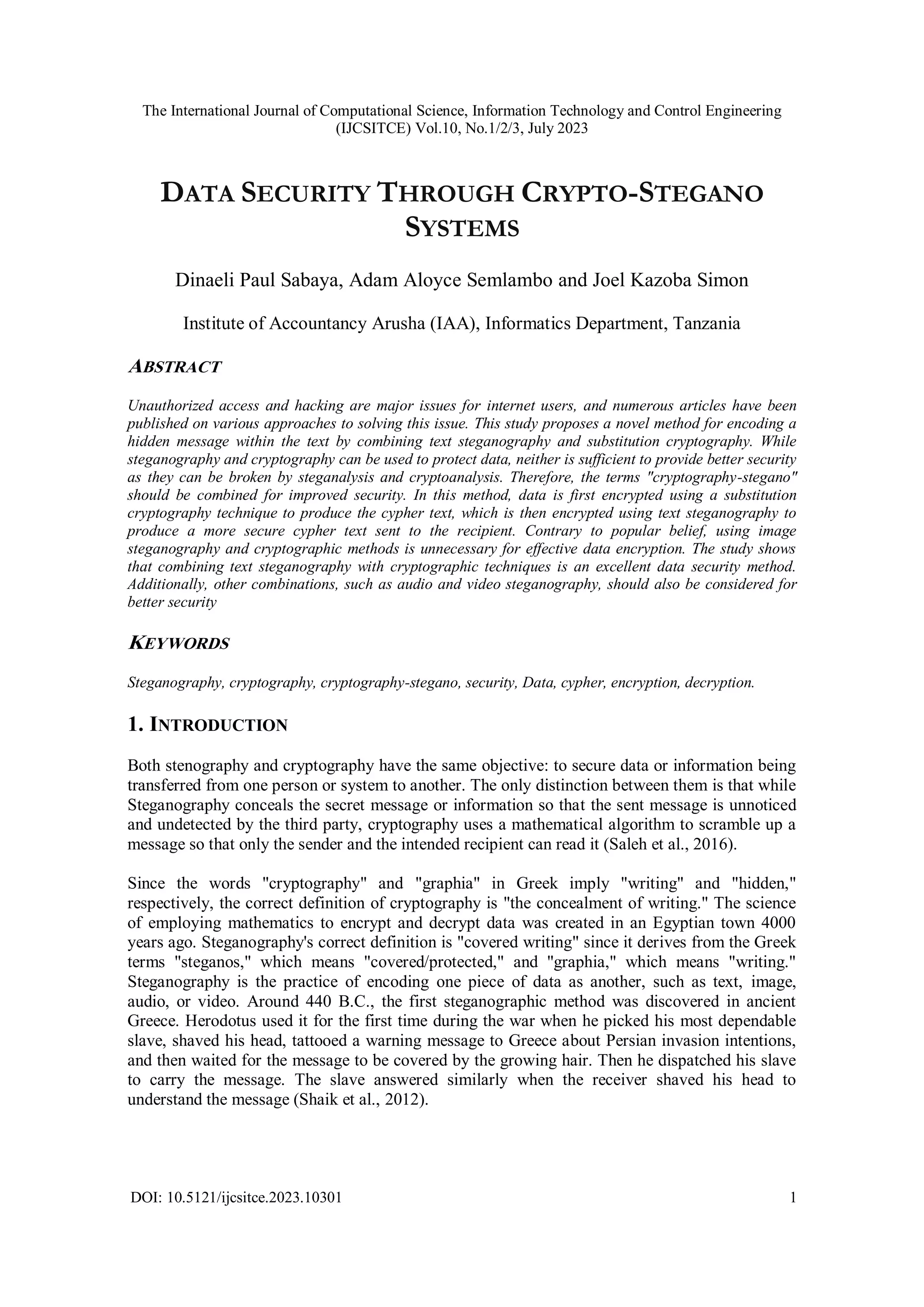
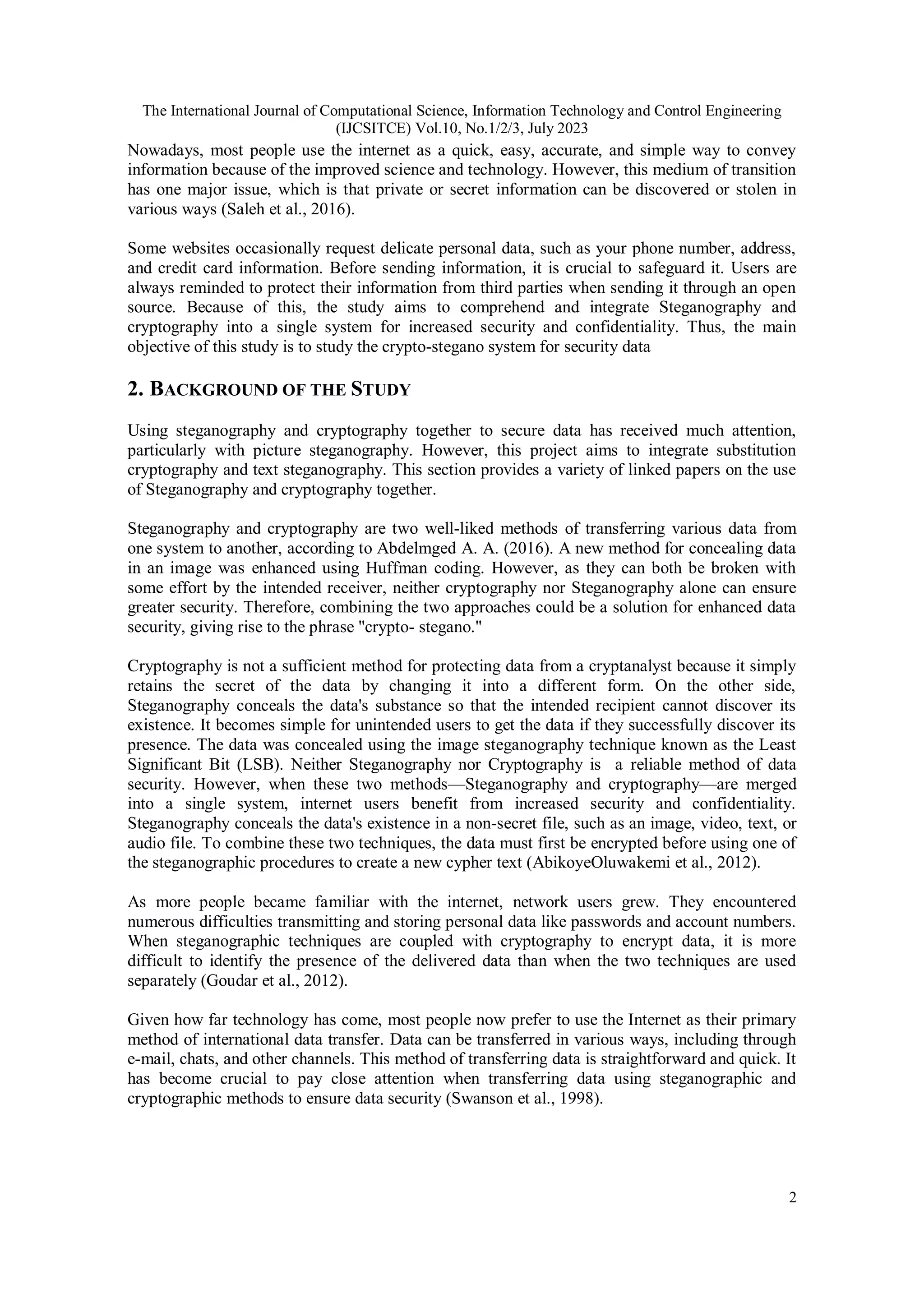
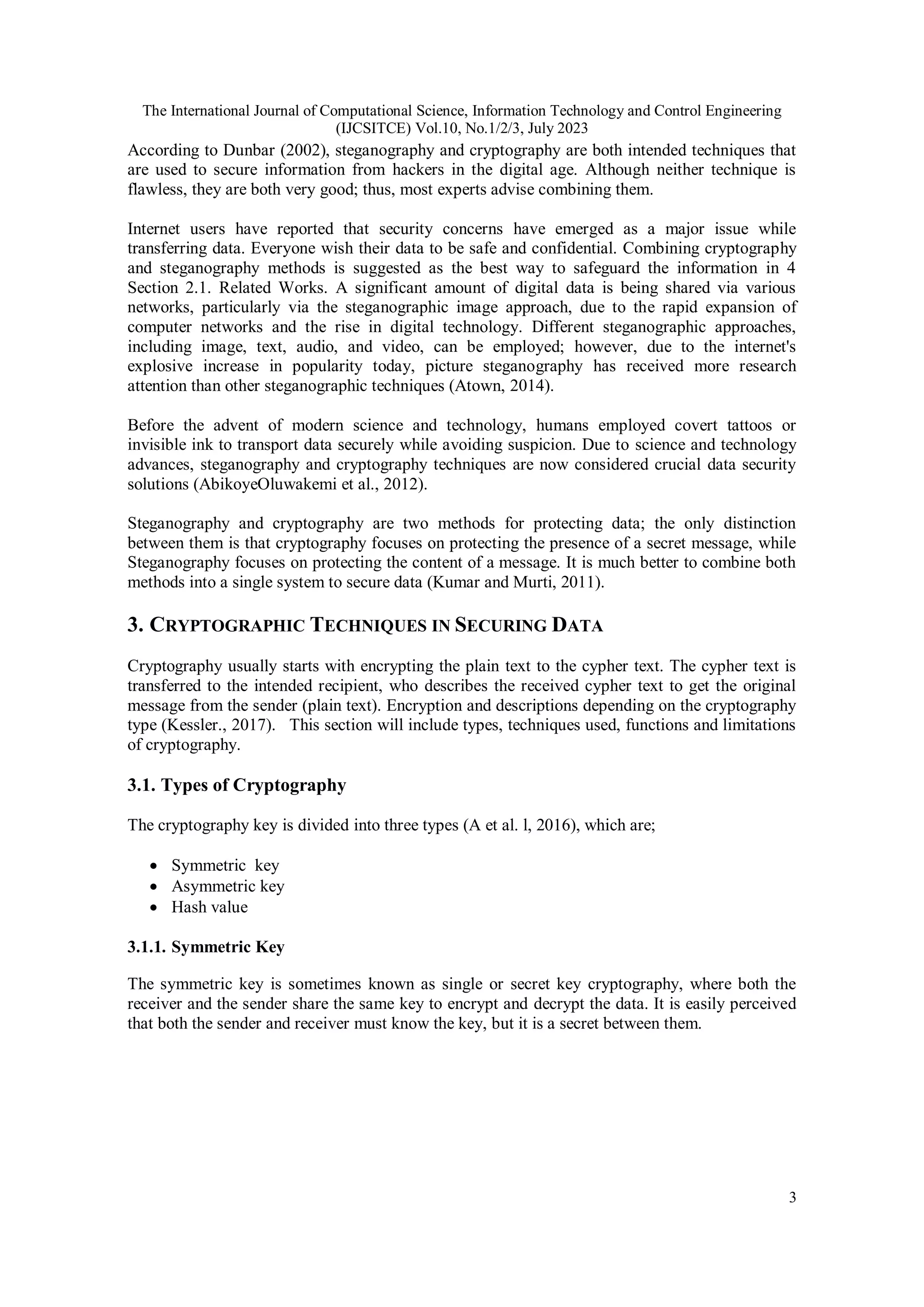
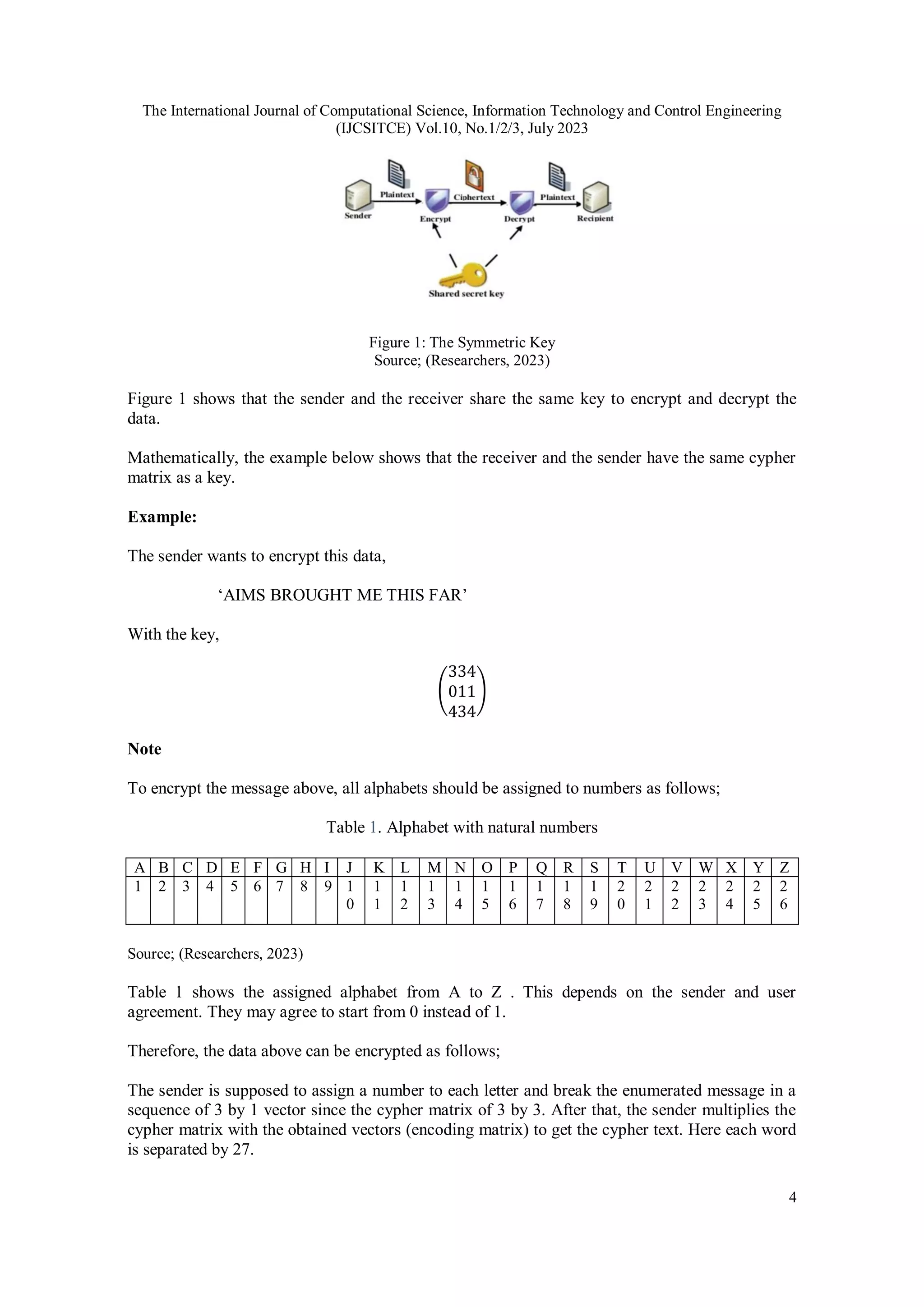
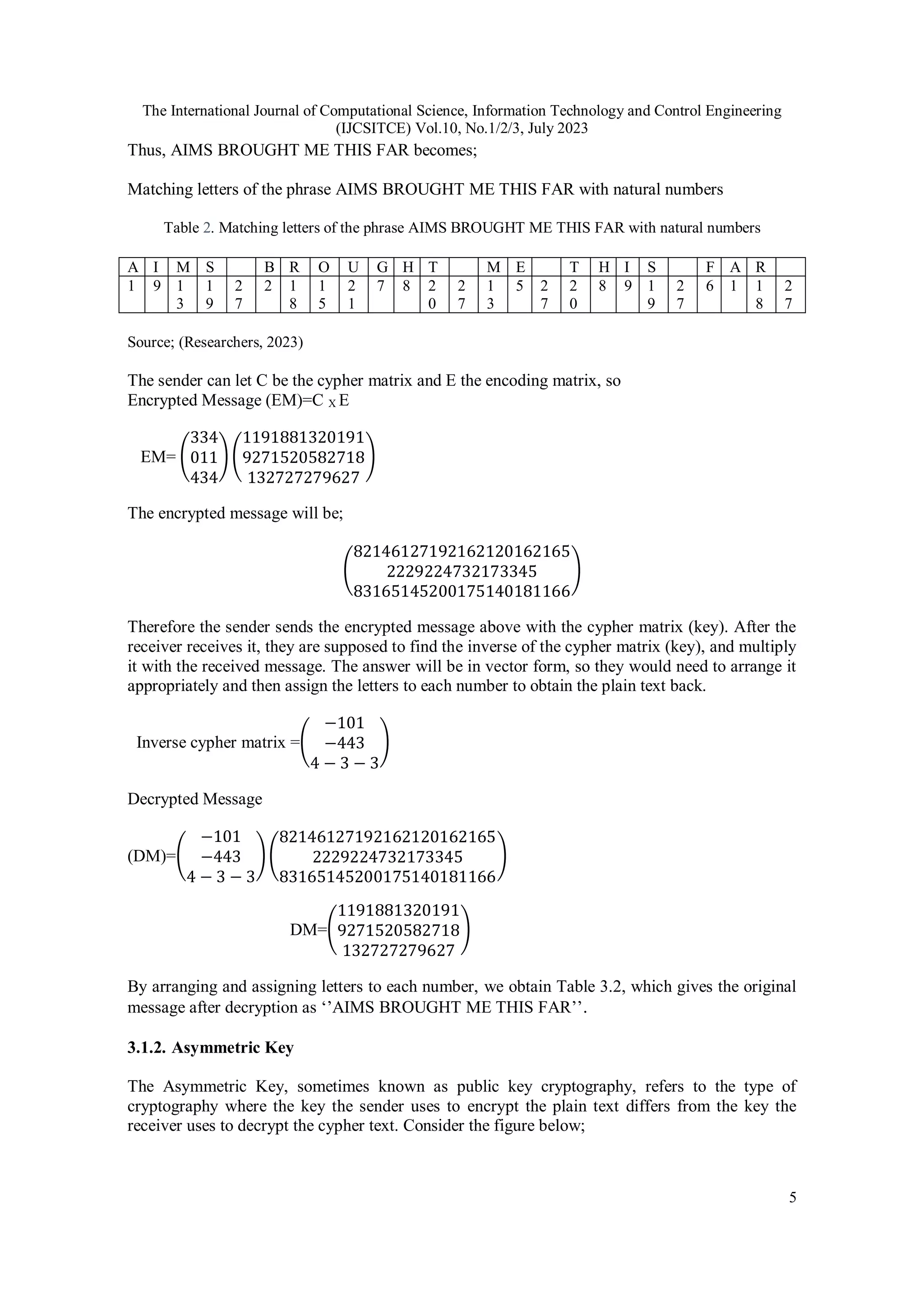
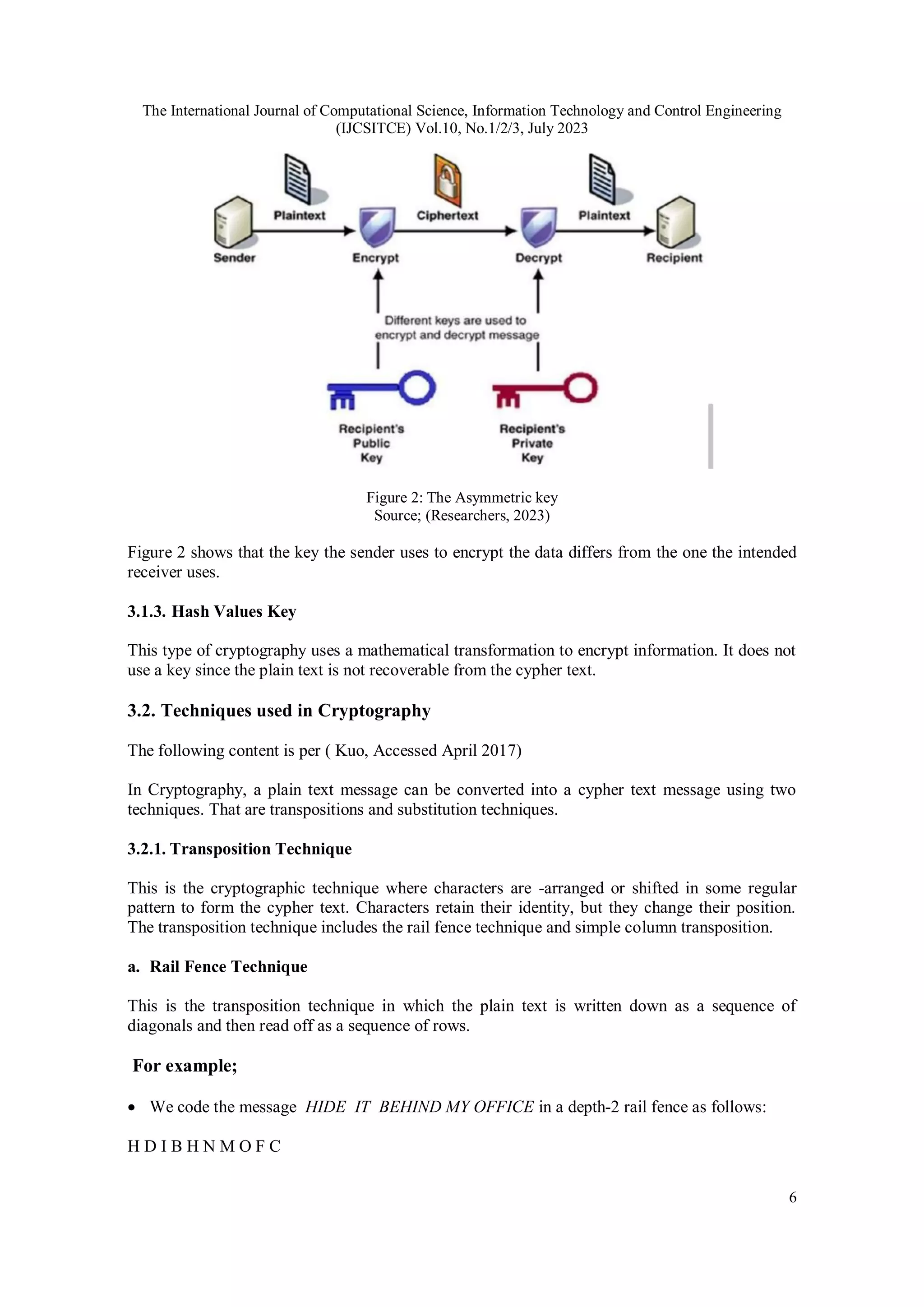

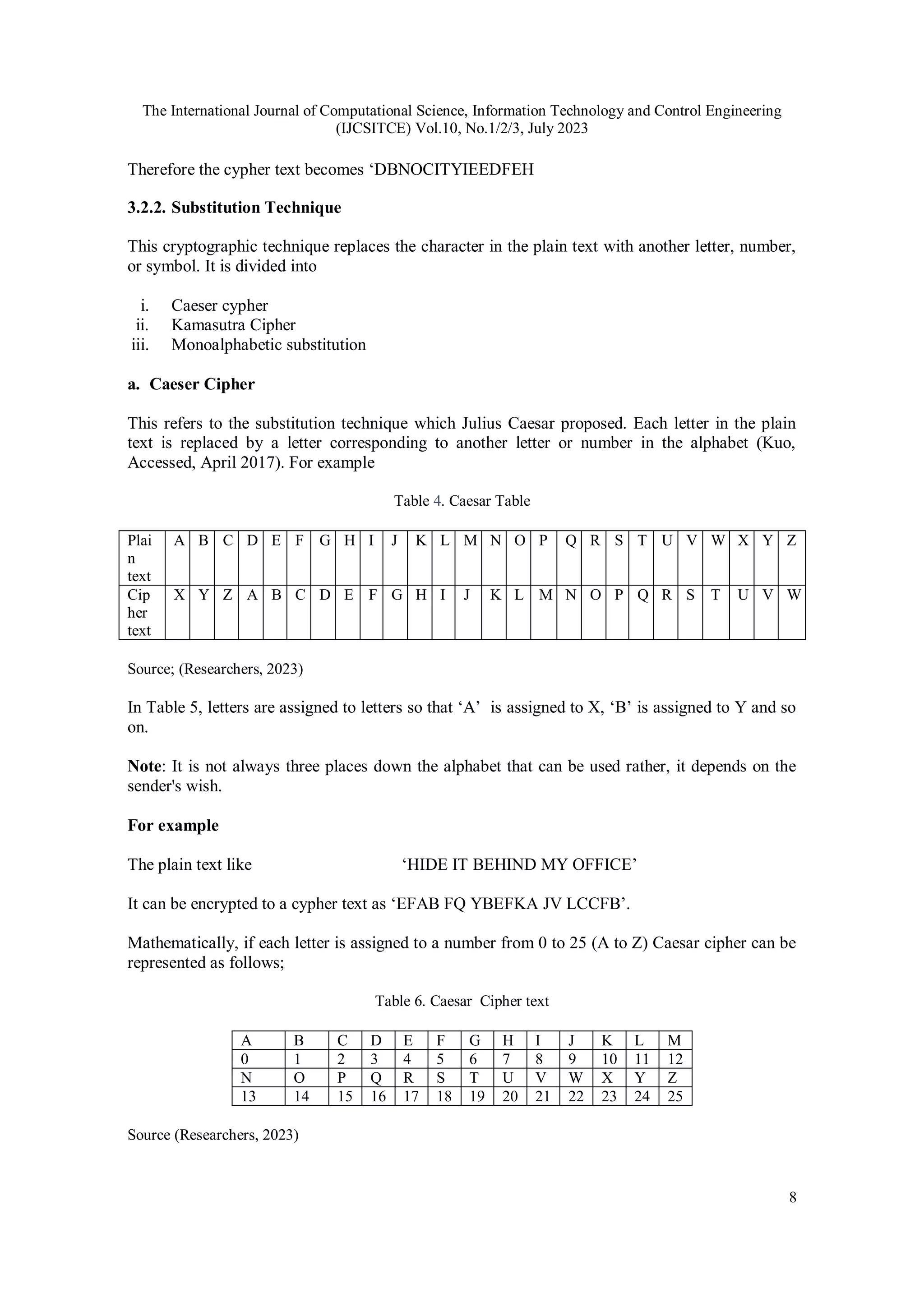
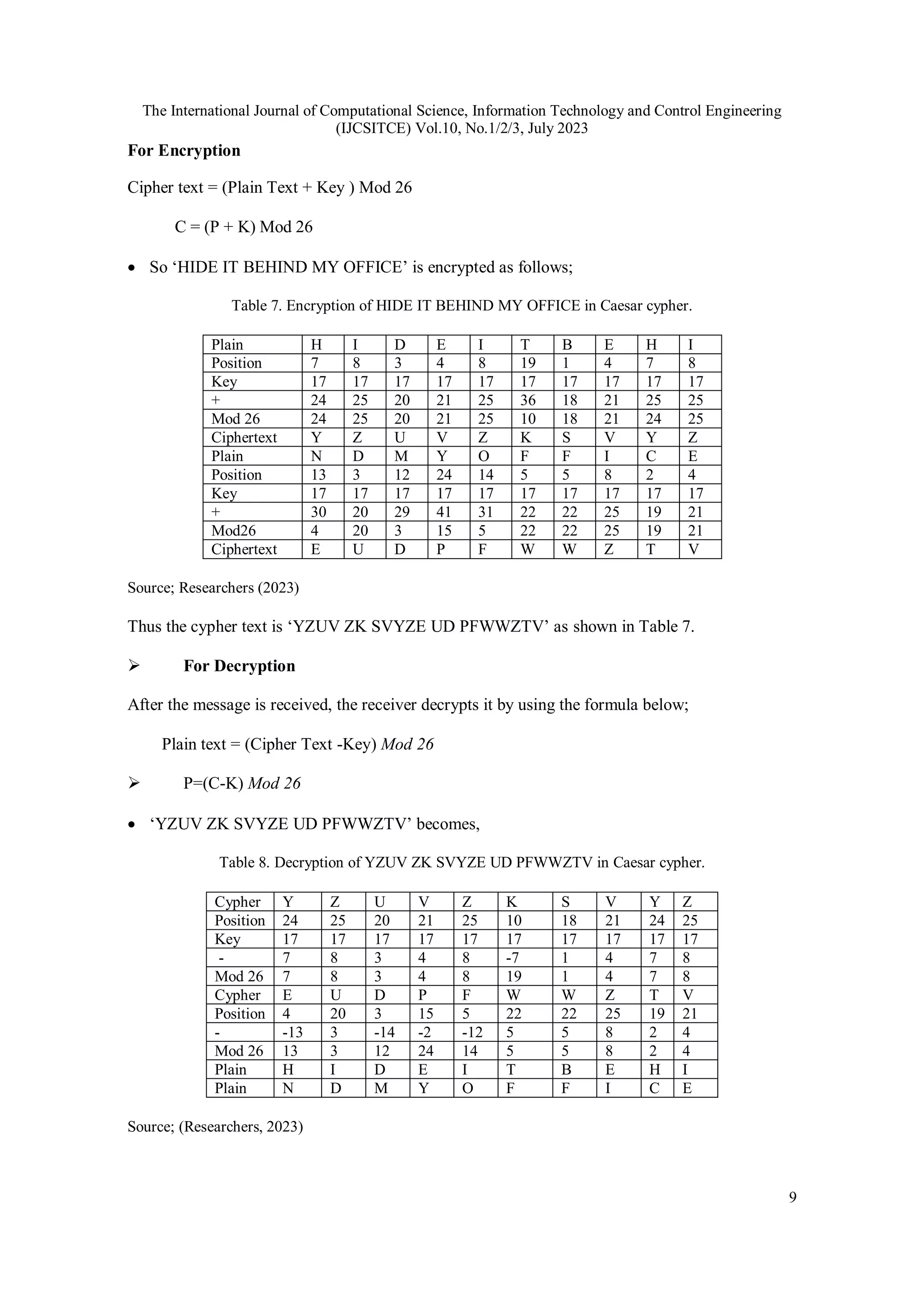
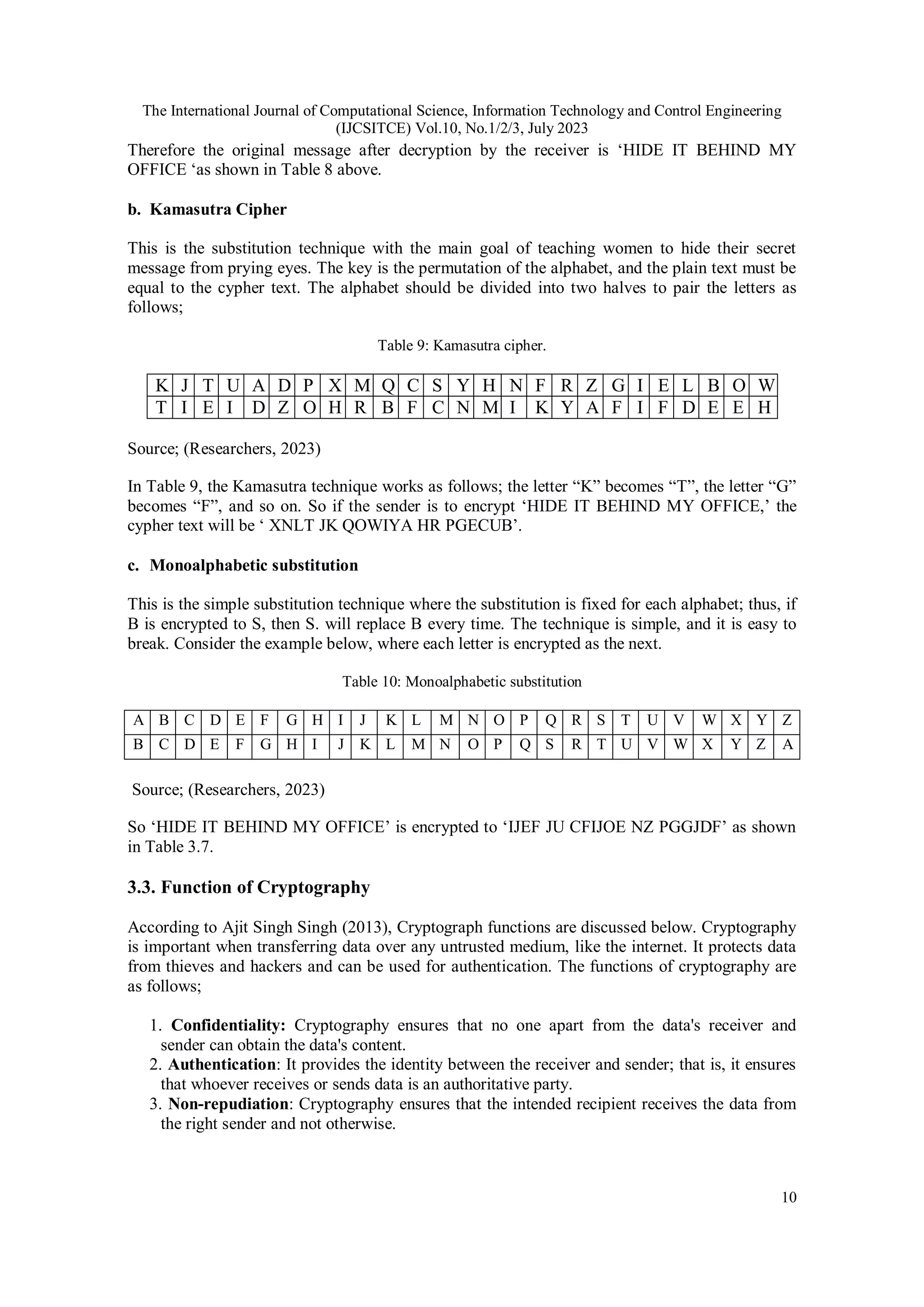
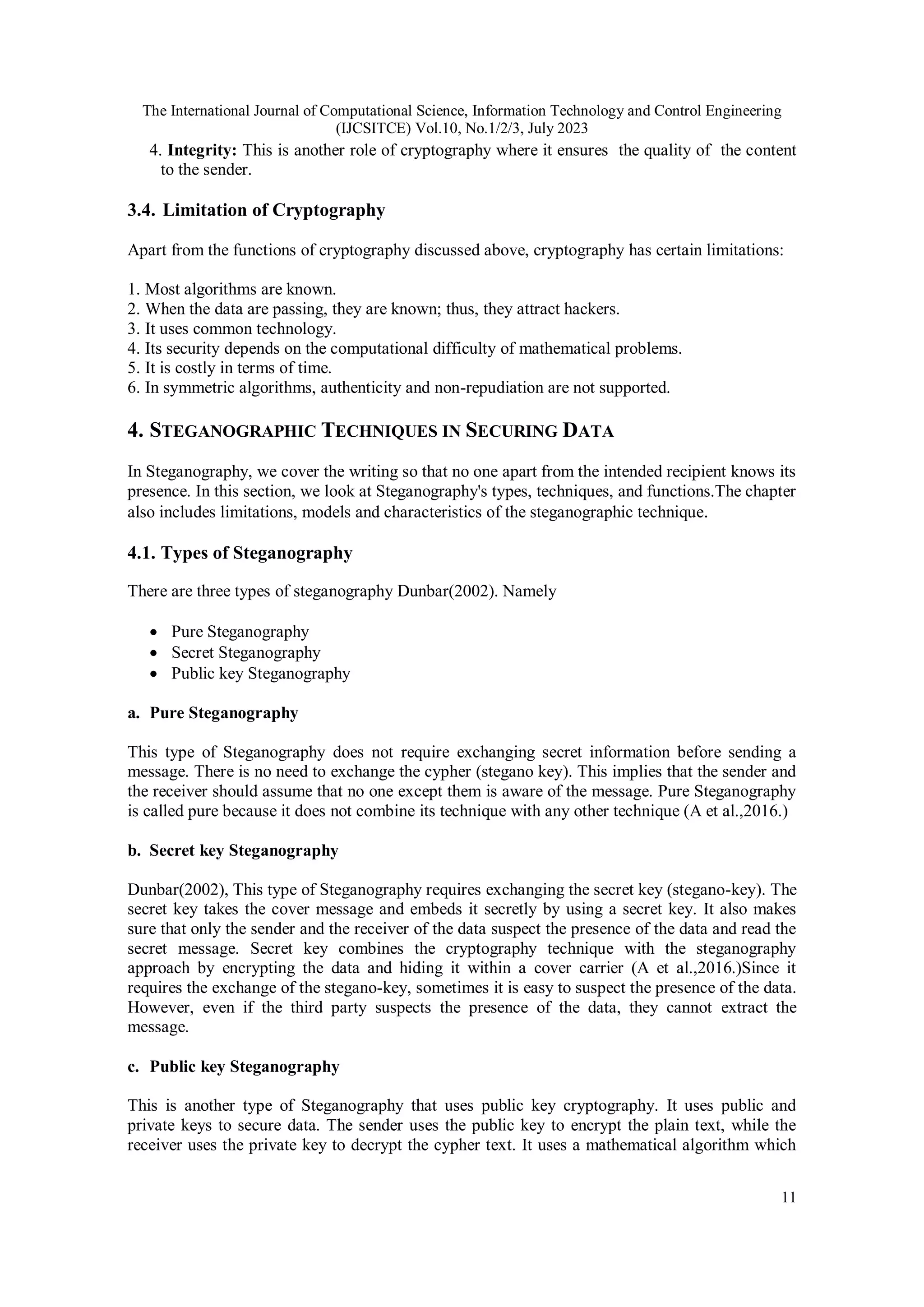
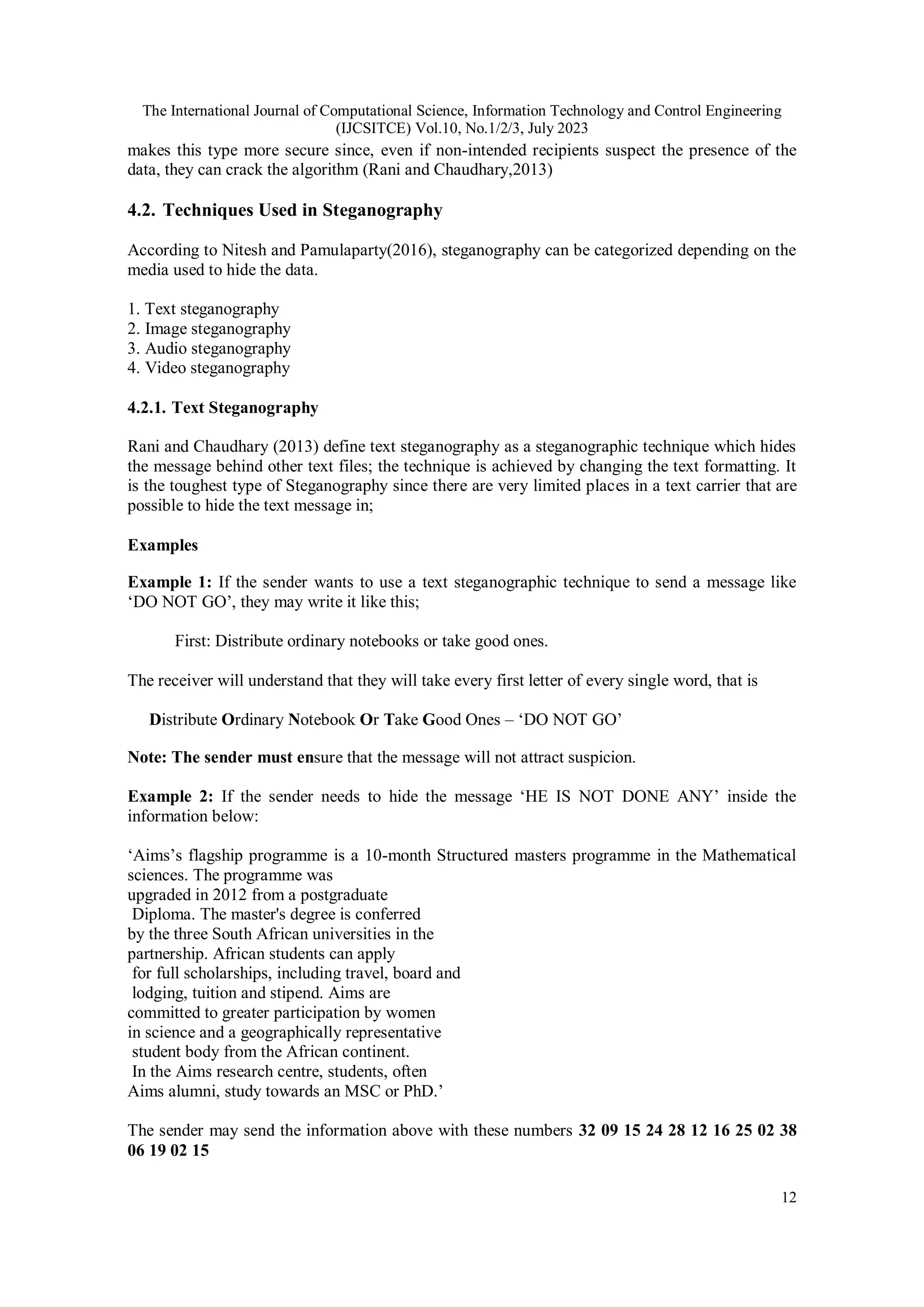
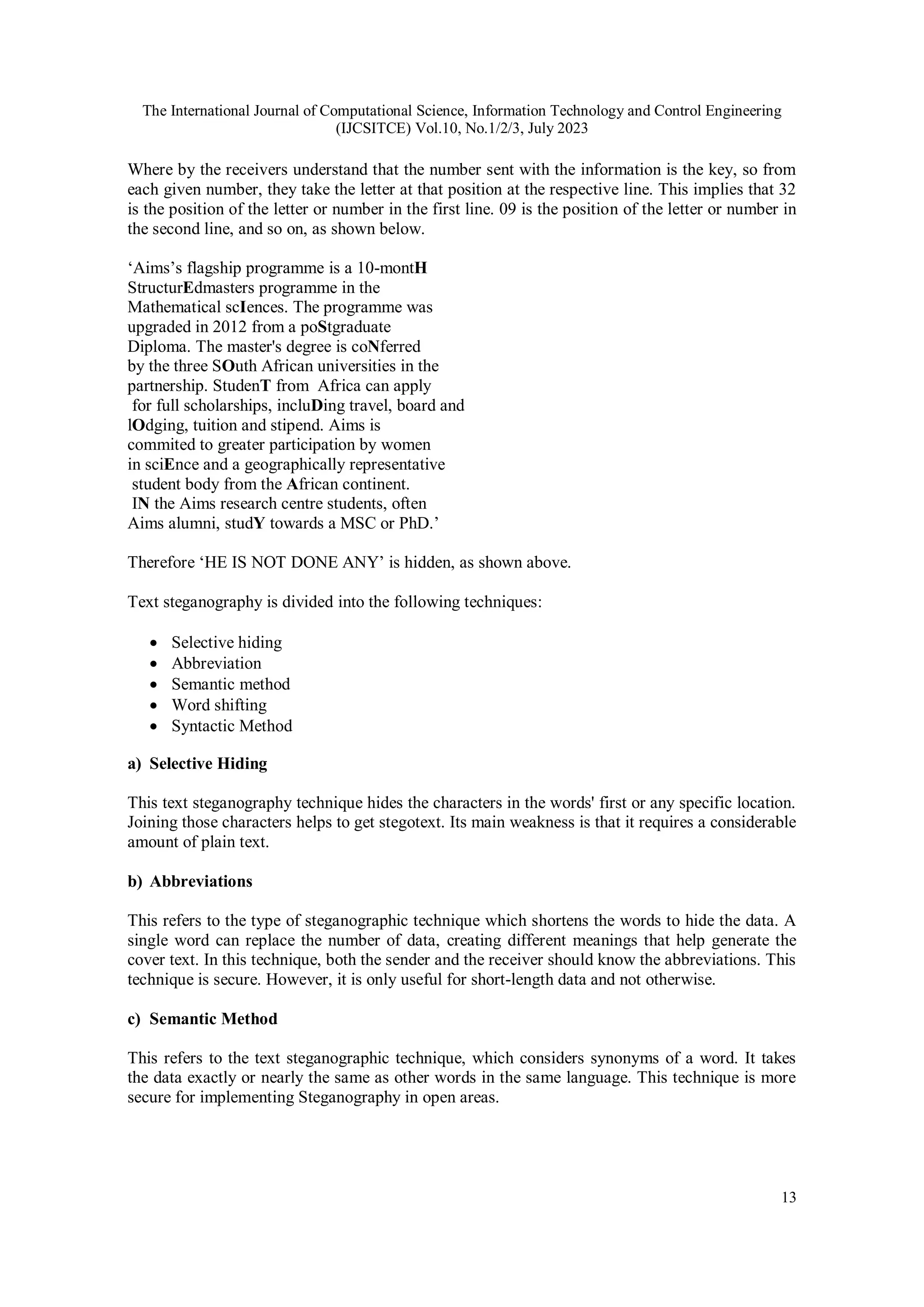
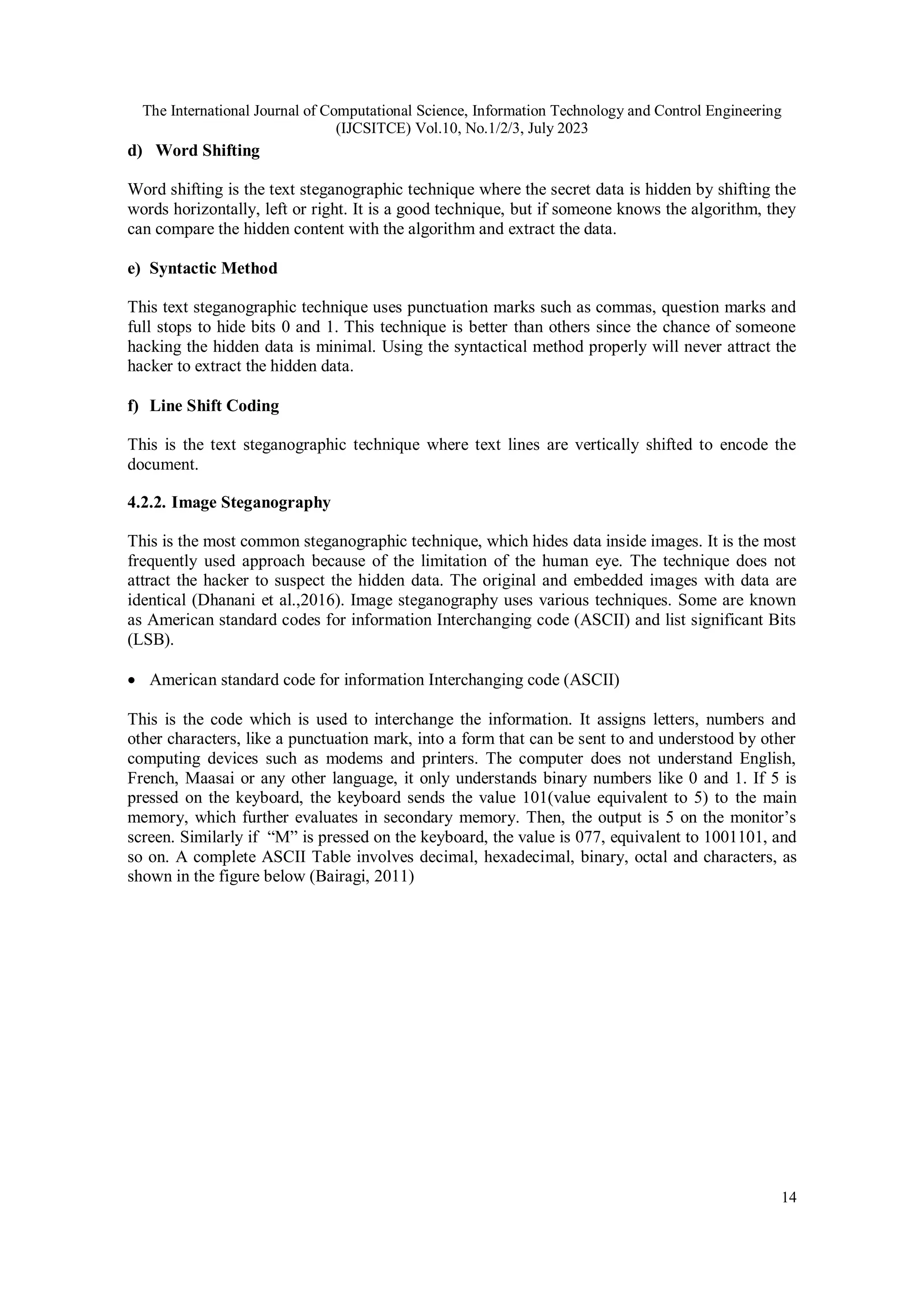
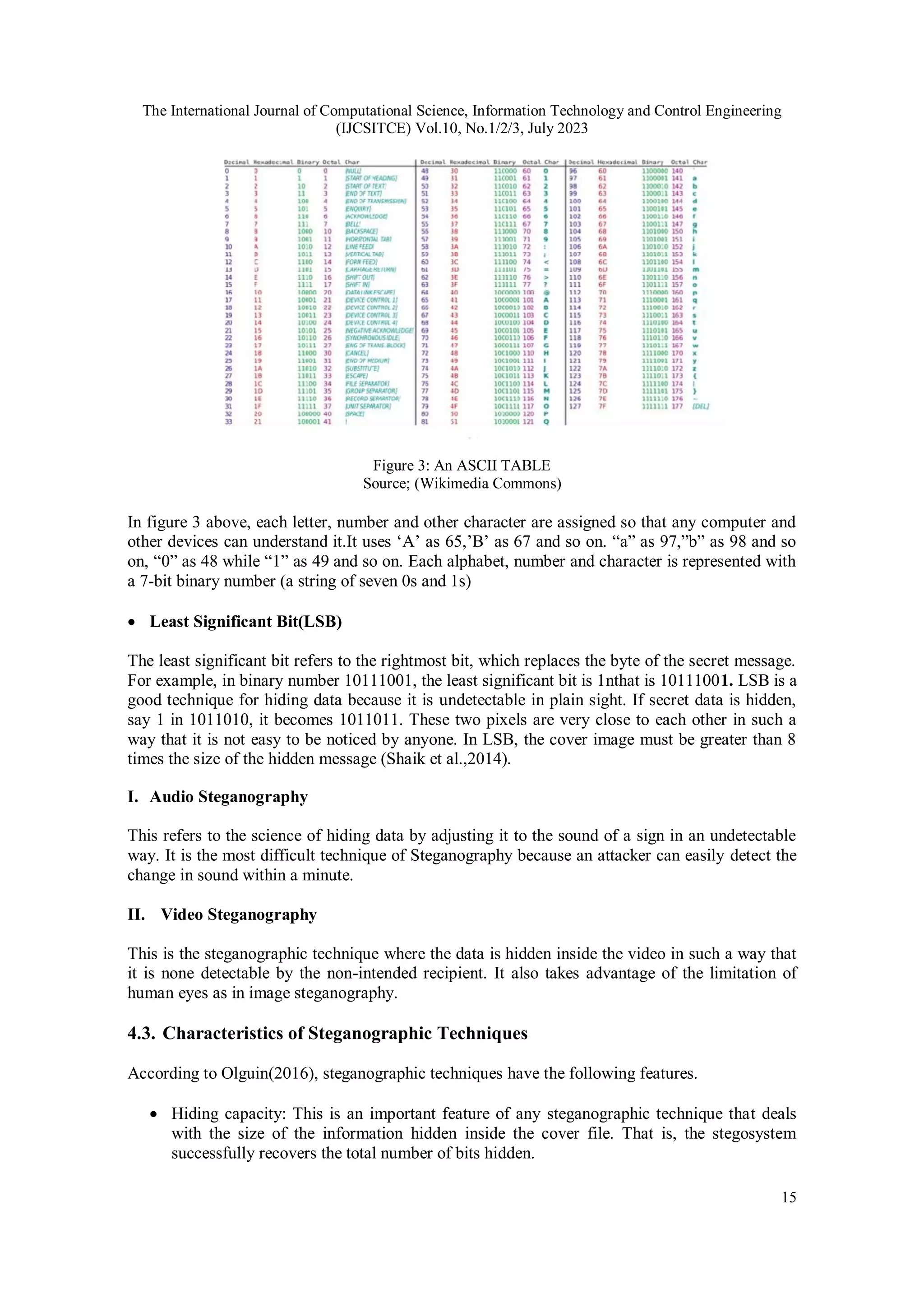
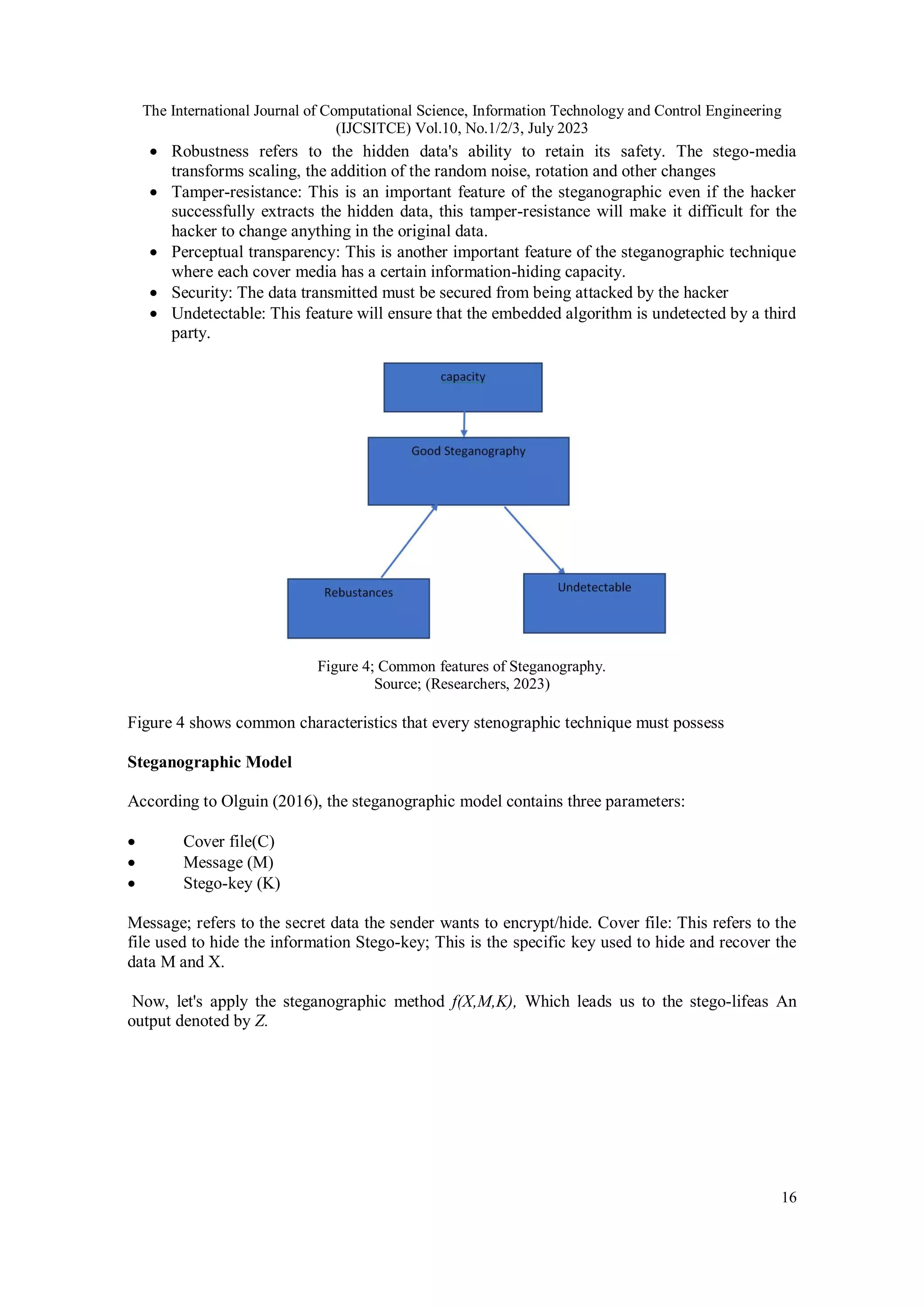
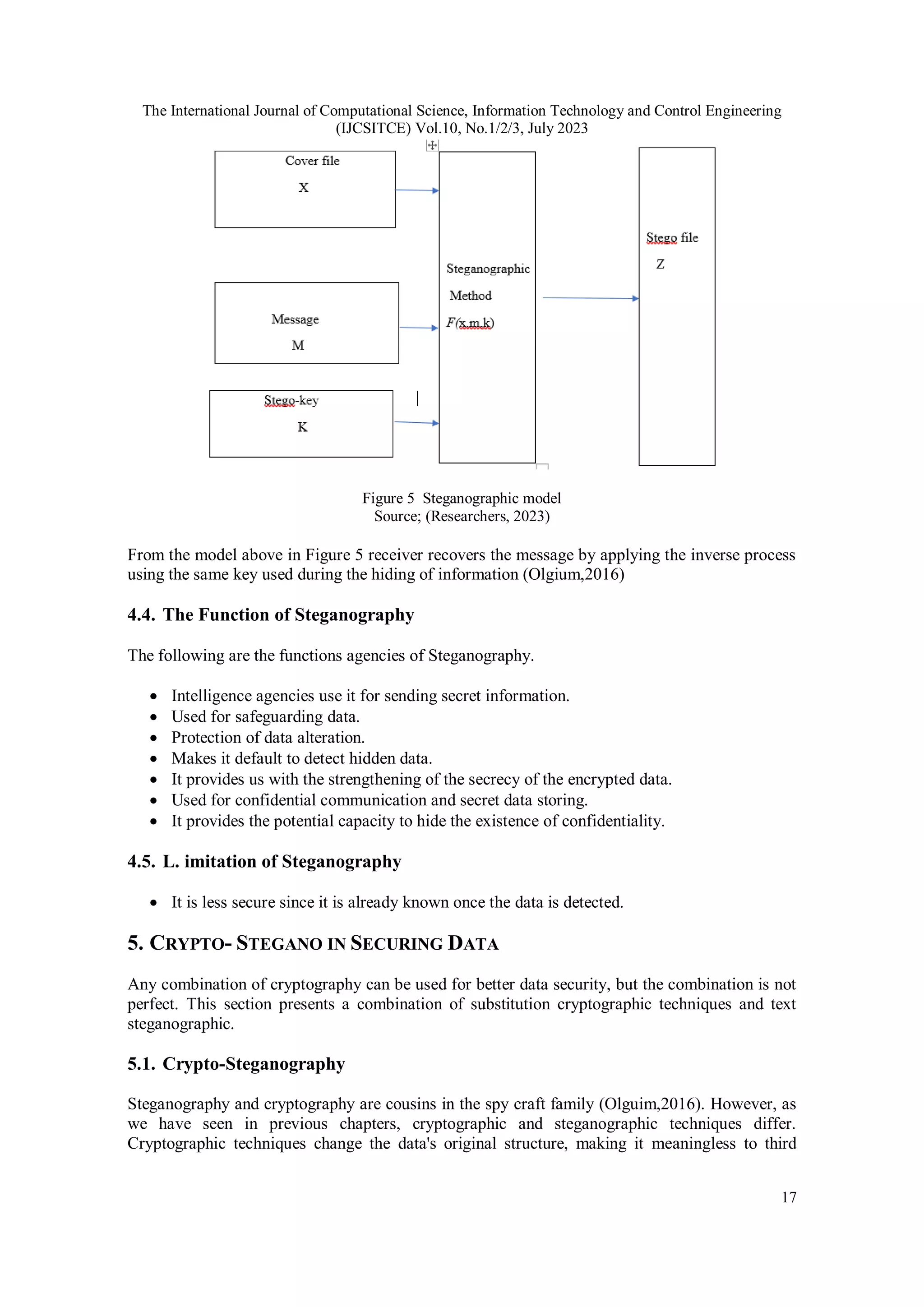
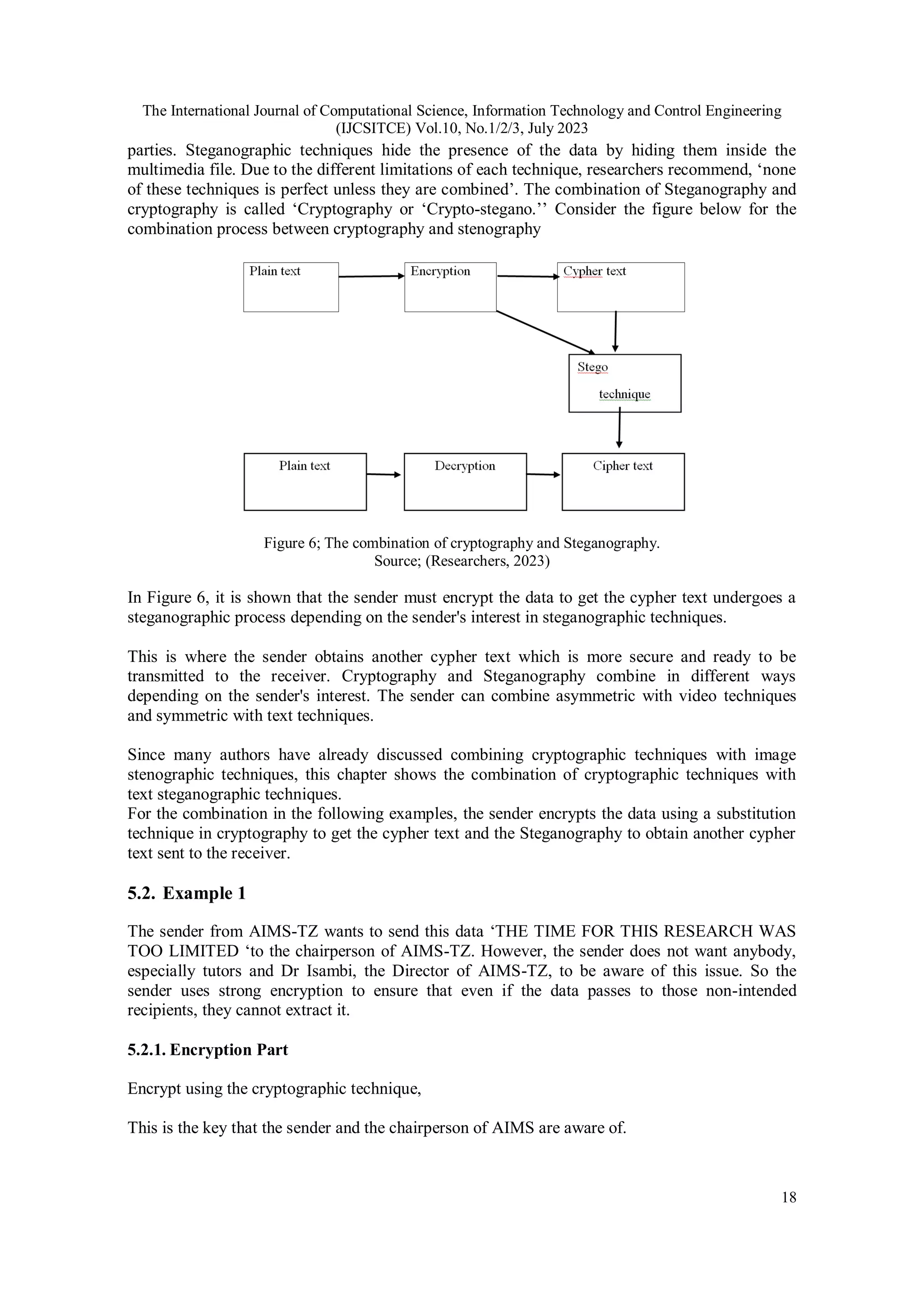
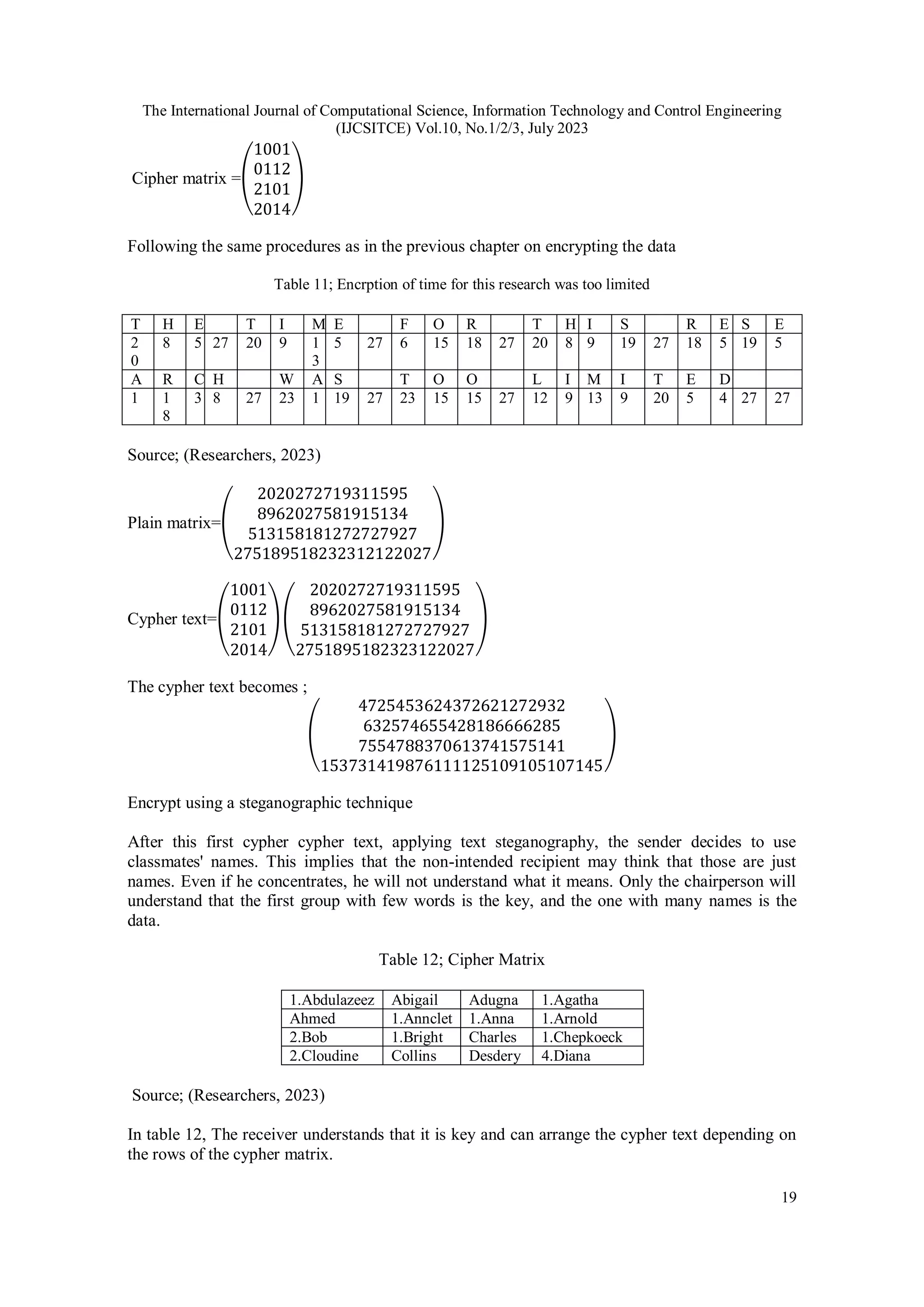
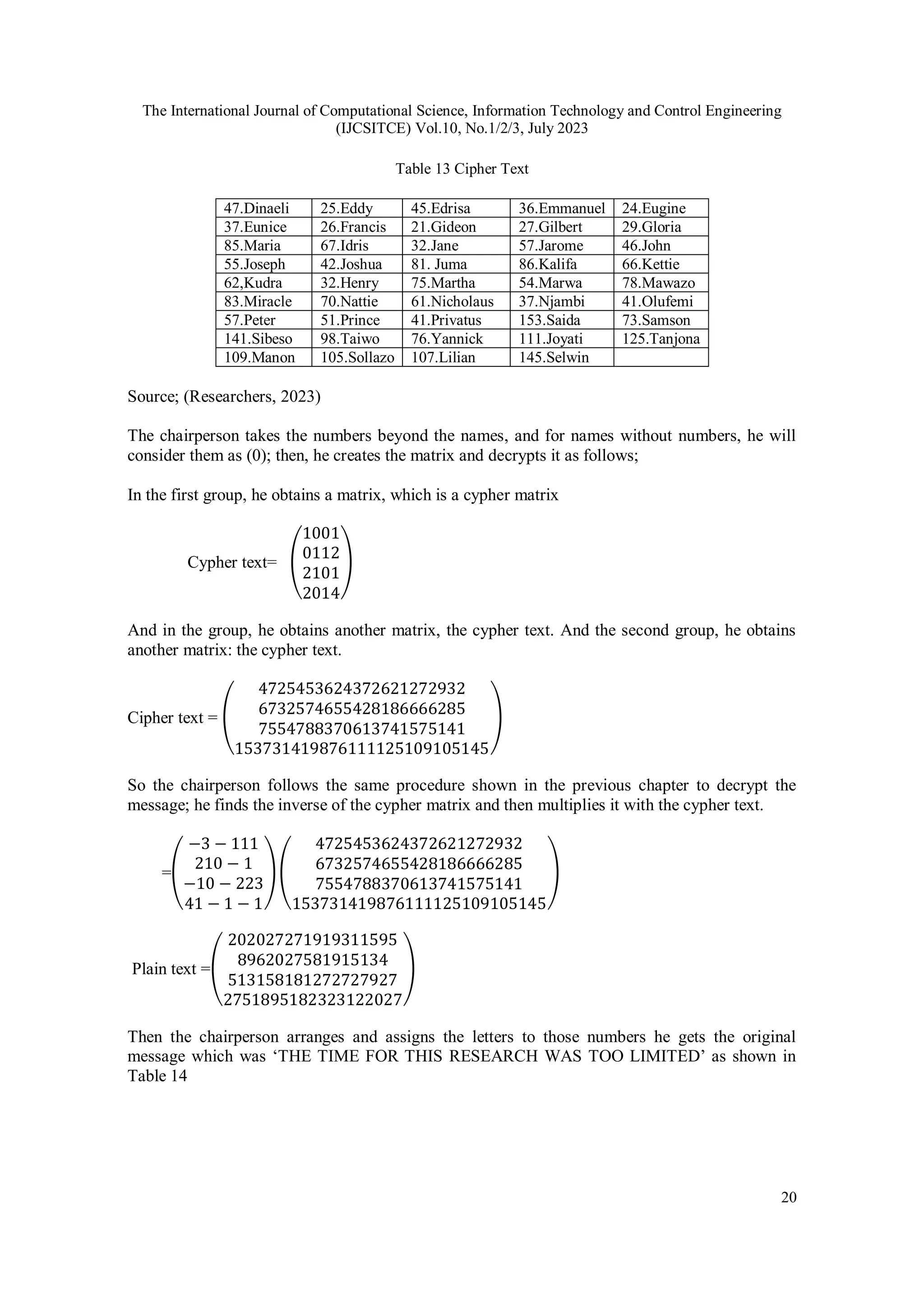
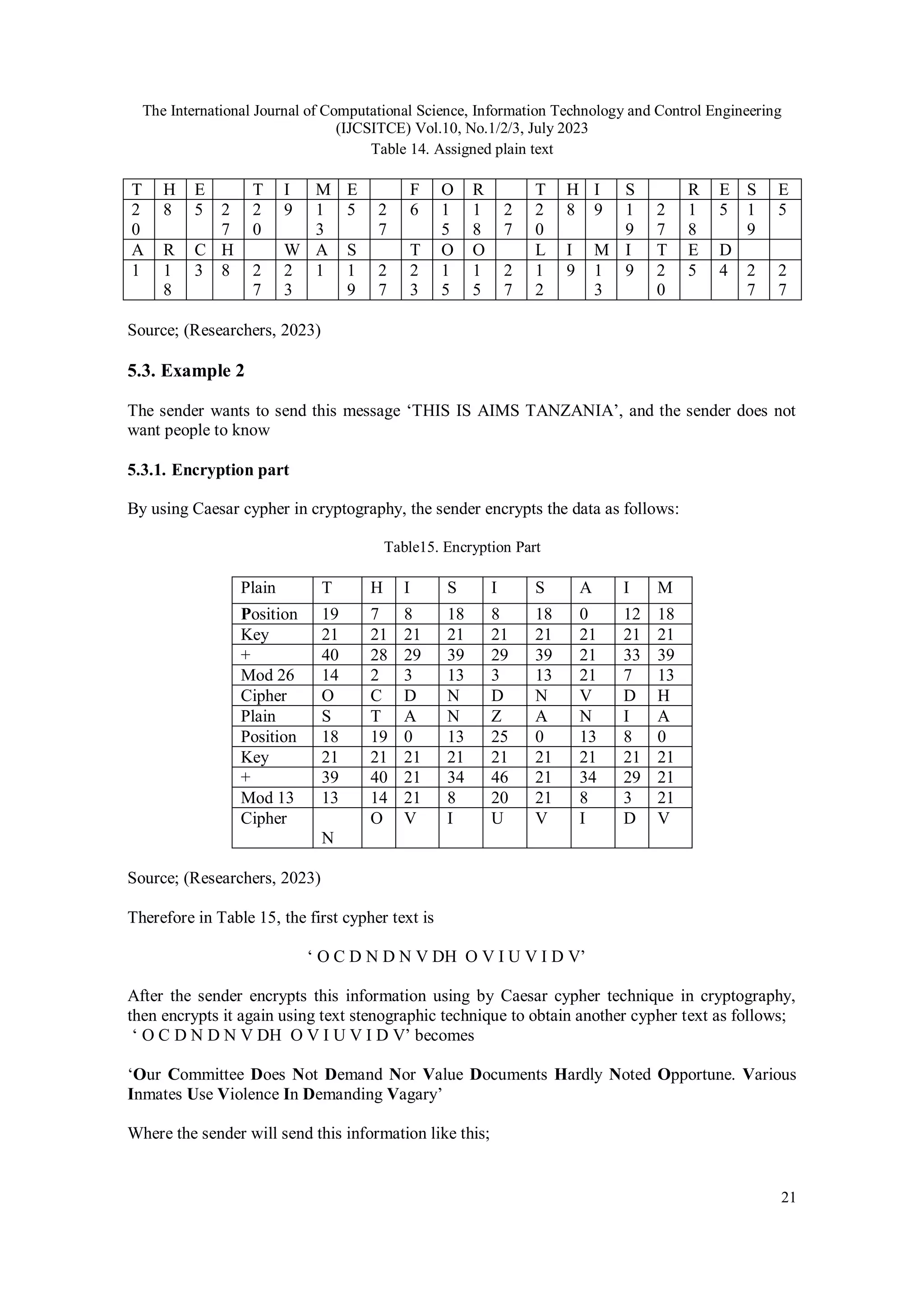
![The International Journal of Computational Science, Information Technology and Control Engineering
(IJCSITCE) Vol.10, No.1/2/3, July 2023
22
Our committee does not demand, nor value documents hardly noted opportune. Various inmates
use violence to demand vagaries [1, 21].
This means that anybody can see this text, and the non-intended recipient understands that this is
as usual information. While the intended- recipient understands to use the first letter from each
word of that information and then decrypt it by using the key ‘21’.
5.3.2. Decryption Part
So the sender decrypts the information as follows;
After taking the first letter of each word, the sender will get ‘ O C D N D N V DH O V I U V I D
V’ and then use the Caesar cypher technique in cryptography with 21 as a key for decryption is as
follow:
Table 16. Decryption part
Cipher O C D N D N V D H
Position 14 2 3 13 3 13 21 3 7
Key 21 21 21 21 21 21 21 21 21
- -7 -
19
-18 -8 -18 -8 0 -18 -14
Mod 26 19 7 8 18 8 18 0 8 12
Plain T H I S I S A I M
Cipher N O V I U V I D V
Position 13 14 21 8 20 21 8 3 21
Key 21 21 21 21 21 21 21 21 21
- -8 -7 0 -13 -1 0 -13 -18 0
Mod 26 18 19 0 13 25 0 13 8 0
Plain S T A N Z A N I A
Source; (Researchers, 2023)
So the receiver obtains the original data, ‘THIS IS AIMS TANZANIA’ as shown in Table 5.6
6. CONCLUSION AND RECOMMENDATION
The study has shown that cryptography and Steganography are well-known techniques for
providing security, especially when combined. This study presents a new approach for combining
cryptography and Steganography using substitution technique in cryptography and text technique
in Steganography. It has been observed that most authors combine the cryptography technique
with the image steganography technique, believing it is the strongest combination. As presented
in this study combining the substitution technique with the text steganography technique is also a
secure combination for securing data. When encrypting the data, it depends on the sender's effort
and critical thinking.
This study recommends that the combination of text steganographic technique and cryptographic
technique is also one of the strongest for securing data. Video, audio steganographic techniques
with cryptographic techniques securing data should also be combined in securing data, and they
are also strong combinations](https://image.slidesharecdn.com/10323ijcsitce01-230810112401-446859a9/75/Data-Security-Through-Crypto-Stegano-Systems-22-2048.jpg)
![The International Journal of Computational Science, Information Technology and Control Engineering
(IJCSITCE) Vol.10, No.1/2/3, July 2023
23
REFERENCES
[1] K. Bairangi. “Ascii based even-odd cryptography with grey code and image steganography. A
dimension in data security”. 1, 2011.
[2] M. Ajitsinh, Madhu Pahal. “study of cryptography and its techniques”.” international Journal of
Advanced Research in Computer Science and Software Engineering, 3, 2013.
[3] A.A, A.-H. S. Saad and N. Hussien. ‘a combined approach of steganography and cryptography
technique based on parity checker and Huffman encoding’. ‘International Journal of Computer
Applications (0975-8887)’, 148, 2016.
[4] A.Siper, R. Farley, and C. Lombardo. ‘the rise of steganography’ 2005.
[5] Dunbar.” A detailed look at steganographic techniques and their use in an open-systems
environment”. “SANS Institute 2002”, 2002
[6] AbikoyeOluwakemi, S.AdewoleKayonde, and J.OladipupoAyatunde. Efficient data hiding system
using cryptography and Steganography. IJAIS, 11(4): 1-6, 2012.
[7] Dhani, K. Panchal, M. Scholar and lecturer. Steganography using web documents as a carrier: a
survey. INTERNATIONAL JOURNAL OF ENGINEERING DEVELOPMENT AND
RESEARCH, 6(4), 2016.
[8] G.C Kessler. An overview of cryptography. 86(6), 2017.
[9] H. Y. Atown. “hide and encryption fingerprint image by using lsb and transposition pixel by spiral
method”. “International Journal of Computer Science and Mobile Computing”.3:624 – 632, 2014.
[10] J. Olguin. Steganography. Available from www. Trustwave.com, 2016.
[11] M. D. Swanson, M. Kobayashi, and A.H Tewfik. Multimedia data-embedding and watermarking
technologies. Proceedings of the IEEE, 86(6):1064 – 1087, 1998.
[12] N. Rani and J. Chaudhary. Text steganography techniques: A review. International Journal of
Engineering Trend and Technology (IJETT), 4(7), 2013.
[13] R. Gouder, P. N. Patil, and A.G. Meshram. Secure data transmission by using Steganography.
Information and knowledge management. 2(1), 2012.
[14] R. M. Kumar and P.R Murti. Data security and authentification using sts protocol(IJCSIT)
International Journal of Computer Science and Information Technologies; 2, 2011.
[15] R. M. Nitesh and L. Pamulaparty. Text steganography: review. International Journal of computer
Science Information & Technology & Security (IJCSITS), 6(4), 2016.
[16] R. Shaik, R.Job and R. massai. “image steganography using lsb + Huffman cod”.International
Journal of Computer Applications(0975- 8887), 99(5),2014.
[17] R.Shaik, R.Job and R. Massai. “data security and authentification using steganography and sts
protocol”. International Journal of Advanced Research in Computer Science and Electronic
Engineering (IJARCSEE), 1(5):PP-114. 2012.
AUTHOR
Adam AloyceSemlambo is a researcher, book author and currently working as Lecturer informatics
department at the Institute of Accountancy Arusha (IAA)
Dinaeli Paul Sabaya,is a researcher and currently working as Lecturer informatics department at the
Institute of Accountancy Arusha (IAA)
Joel Kazobais a researcher and currently working as lecturer informatics department at the Institute of
Accountancy Arusha (IAA)](https://image.slidesharecdn.com/10323ijcsitce01-230810112401-446859a9/75/Data-Security-Through-Crypto-Stegano-Systems-23-2048.jpg)